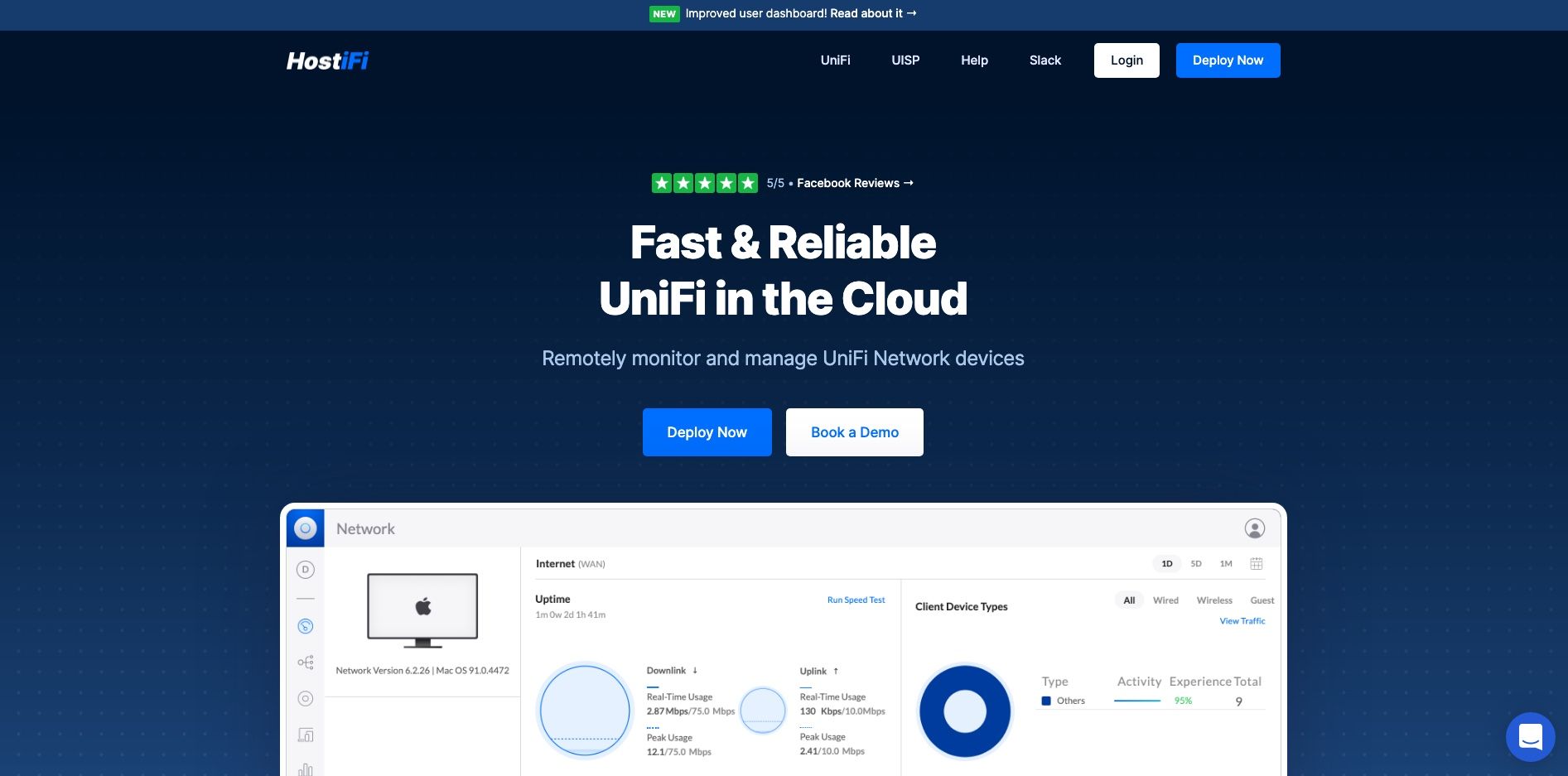2021 year in review

It's been 3.5 years since I launched HostiFi now. Probably the coolest thing that happened this year is the business crossed $1M ARR in September, 10Xing from $100K ARR just 2 years ago. Revenue also exceeded $1M this year for the first time.
- Server count increased from 1,362 to 2,117
- ARR increased from $580K to $1.3M
Building the team was the biggest highlight though.
Building the Minimum Viable Team
This is the year I really built a team and made the transition to primarily supporting others instead of doing work myself. Across support, design, web dev, and sales - I managed to remove myself from the day to day operations.
There aren't many lessons from this year more important than that. Learning to delegate has been the hardest but highest value and most rewarding skill I've ever worked on.
I love where the business is at now. If I ever had to start over, I would want to get back to this place as soon as possible and skip those first few years which were really hard, stressful, and broke. I'm doing my best work now as a team lead instead of an individual contributor. Everyone on my team knows more than I do in their roles and I love that.
Here's how the team has evolved, included time and revenue for context -
$0-$100K ARR
May 2018-August 2019
- Me - Part-time until January 2019 then full-time since, web dev, Python dev, design, sales and marketing, support
$100K-$580K ARR
August 2019-December 2020
- Me - Full-time web dev, Python dev, design, sales and marketing
- Safwan Shaikh - Full-time Technical Support Engineer
$580K-$1.3M ARR
January-December 2021
- Me - Full-time Python dev, marketing
- Safwan Shaikh - Full-time Technical Support Engineer
- Vinay Manro - Started as part-time, now full-time "Customer Success" which is a blend of sales, onboarding, proactive server maintenance and support
- Fabian Tomischka - Started as part-time, now full-time Laravel dev
- Saifuddin Khan - Full-time Technical Support Engineer
- Waheed Shaikh - Full-time Technical Support Engineer
- Youssef Sarhan - Part-time designer and Webflow developer
- Cory Cooper - Part-time NodeJS dev working on a centralized management of proxies on all servers which will give us additional control over security, features, and SSL management
I waited too long to hire because I never wanted to be a manager, but now that I'm finally embracing the role and getting the hang of it, I love it.
We're hiring for 2022!
Design and engineering
Rebrand
Youssef gave the HostiFi brand a refresh with a new color scheme, landing page, images, and social media banners.


Migrated from hostifi.net to hostifi.com
I purchased hostifi.com back in August 2019, but it wasn't until March of this year that I finally put in the time to migrate off of .net.
It was a huge effort, a lot of checklists and preparation went into it. In addition to code rewrites, one of the biggest challenges was reissuing over a thousand SSL certificates issued through Let's Encrypt for our customer servers who were using subdomains of our domain.
In the end it took 16 hours straight and everything went pretty well, only one order placed during the migration was mixed up and had to be manually fixed.
Main site split into to app.hostifi.com and hostifi.com
Until this year we just had one site running on WordPress at hostifi.com which served as both the landing page and app. During the .net to .com migration I installed a second copy of the WordPress site at app.hostifi.com, disabled the functionality on hostifi.com and linked to app.hostifi.com for the app related pages.
This had an immediate benefit which was that I could install a plugin on hostifi.com which allowed people to get an invite to our Slack channel without breaking functionality of other plugins on the app.hostifi.com WordPress site, but it was also a set up for the next phase which was replacing hostifi.com with our new Webflow site built by Youssef as well as replacing app.hostifi.com with our new Laravel site built by Fabian.
If I did it again I'd split the landing pages from the app from the start next time, it makes it much easier to update the landing pages without worrying about breaking functionality of the app. It's a pain to separate it later.
hostifi.com WordPress to Webflow migration
This was pretty straight forward from a technical standpoint thanks to the previous work splitting the landing pages from the app. Youssef put in a lot of work on the design side. When we launched the new Webflow site it linked back to the WordPress pages at app.hostifi.com, and later when we launched the new Laravel site at app.hostifi.com we just relinked it. The new site design looks way better than the WordPress template before it.

app.hostifi.com WordPress to Laravel migration
It took 2 years, over 1,200 hours, and $95,000 not including my own time. Completely rewrote the site 3 times. Finally made it though and it's a huge relief. The new site launched as an MVP but still brought a bunch of improvements.
Most importantly though, we're able to keep developing new features on it now without the limitations we had before working on WordPress.


Python full rewrite
In February I completed a project that I had started the previous summer - I rewrote every single line of Python code from tons of procedural scripts which were often copy and pasted between each other. I organized it all into a single repo of scripts which pull from the same classes. Over 6,000 lines of code at the time, and it's now over 13,000 lines today.


Built "support-tools" scripts
I wrote a collection of scripts for our support team to automate common procedures like creating Super Admin accounts, counting devices, installing SSLs, taking a manual backup, or putting a server into maintenance mode.
The scripts are installed on every server and we use Termius snippets shared between the team which allow us to run those scripts with one click. A few minutes of time saved per person per day can really add up.
Always thinking 10X
$100K to $1M ARR
$1M ARR was a 10X goal I set in October 2019 after getting to $100K ARR - I predicted $1M ARR by September 2022 but it arrived an entire year ahead of schedule.
$1M ARR felt so far away when I set that goal, it was hard to imagine what that would be like. It forced me to think about questions like:
- How many customers would we have at $1M ARR? How many new customers each month?
- How many visitors will I need to have on the website to support that number of monthly conversions at $1M ARR? How can I scale marketing efforts to eventually get that much traffic flowing?
- How many support tickets per day will come in?
- How many support hires will I need to answer all of those tickets?
- How many demos will be booked each day from the website and how many people will need to be handling that?
- Can our current website scale to support that many customers?
- What will the org chart look like at $1M ARR?
- What will my day to day work look like then?
$1M to $10M ARR by September 2024
When we made it to $1M ARR I set a new 10X goal - $10M ARR by September 2024. I'm thinking through many of the same questions again.
One thing that's cool - growth has been very predictable since I started HostiFi. I've done this exercise before where I wrote down our current revenue, calculated average MRR growth, then projected out a year or two based on average percent of monthly growth, forgot about it and came back way later to see it was surprisingly accurate.
I set this $10M ARR by September 2024 goal that way, you can see the spreadsheet here: https://docs.google.com/spreadsheets/d/15UJOjaqF7aId23BXChKxzKUuf21xycYHn1dBm0WJoF8/

I made the spreadsheet in August and estimated ARR at the end of December would be $1,322,453. Actual ARR turned out to be $1,322,520.
Deciding not to sell
2021 was the year I thought about selling for the first time.
I talked to FE International in April and they told me they could list HostiFi for $2.43M and it would be sold within 6-8 weeks. ARR was $723K at the time.
Life changing money.
Totally blows my mind.
But I couldn't do it.
I kept thinking this is exactly what I wanted when I started it, why I am hesitating to cash out now that I finally made it?
I used to get serious anxiety about it. If you've ever held some stock on the way up like $GME, that's the only feeling I can relate it to. There are two fears happening at the same time. The fear of selling too soon, and the fear of selling too late. You'll probably feel bad no matter what.
So what do you do?
I think the best thing is to just take some profits but not sell the whole position. If you're up on a stock, lock in some winnings but let the rest ride and see what happens.
That's what I did this year, I paid myself well and I had some conversations with investors about selling 10 or 20% of the business as a secondary that I could cash out rather than selling the whole business.
I'm still reinvesting heavily, but if I didn't pay myself well on the way up then selling could become too tempting.
This is so cheesy and off brand for me to say, but honestly money is just one part of it now too. I think about not just what the best outcome is for me but for the customers, the team, and the investors.
Maybe the real MRR was the friends we made along the way
— @levelsio (@levelsio) November 5, 2021
This is a business I could see myself running for the next ten years without losing interest. I think that's a rare thing to be able to say.
If I sold it, what would I do?
I'd just build another HostiFi. There's nothing I'd rather be working on.
In 2006, 22 year old Zuckerburg turned down a $1B offer to sell Facebook to Yahoo, here's what he said about it.
Thiel recalled Zuckerberg said, in a nutshell: "I don't know what I could do with the money. I'd just start another social networking site. I kind of like the one I already have."
In 2013, 23 year old Evan Spiegel of SnapChat turned down a $3B offer from Facebook, here's what he said about it.
"There are very few people in the world who get to build a business like this," Evan Spiegel, co-founder and CEO of Snapchat, told Forbes in an interview. "I think trading that for some short-term gain isn’t very interesting."
Those quotes always stuck with me because it's so crazy, it's hard to imagine turning down those offers.
But it makes more sense to me now than ever.
There are a few parts to it I think:
- They didn't have anything they'd rather be working on
- They didn't want to miss out on the personal growth and learning opportunity of continuing to grow the business
- They really felt the businesses would be worth more than the offers, and both turned out to be right
This is the same thought process for me, just on a much smaller scale of course.
With that said though...
Robert Pera, if you're reading this, I'd love to sell HostiFi to Ubiquiti in 2022.
